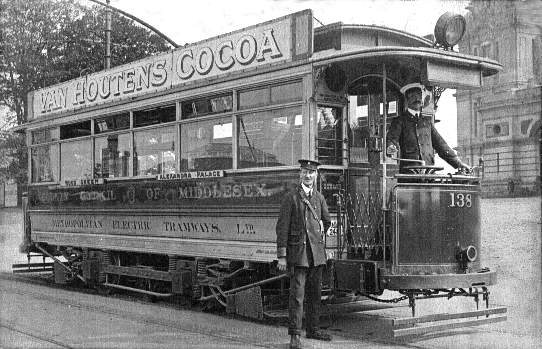

Our postcard shows tram 138 standing outside the east end of the Alexandra Palace in North London. It is a real photographic card produced by local photographer S.A.King of 7 Bedford Road, Alexandra Park (the tram would have passed by his premises) and dates from around 1913.
The Alexandra Palace, "Ally Pally" to Londoners, was opened in 1875 and, together with its grounds, continues to provide a useful public amenity. From 13th May 1898 to 20th September 1899 it was served by the Alexandra Park Electric Railway using German-built trams. Some therefore claim that this was the first electric tramway in London rather than the London United Tramways, which were electrified in 1901. During the Great War, the Palace was used first for troops, then Belgian refugees and finally for German internees. In the 1930s it was the home of the studios and transmitter for the BBC's first television broadcasts.
Two tram routes of the Metropolitan Electric Tramways (MET) were built to serve the Palace and park. The first was opened on 6th December 1905 and ran from the "Wellington" in Turnpike Lane to Alexandra Palace West. A second route was formally opening on 9th April 1906 with a public service starting two days later, and ran from Wood Green via Wood Green Station to Alexandra Palace East, the section in the park being partly on the site of the former Electric Railway. In 1908 it was proposed that the lines be linked across the front of the Palace, but this was not pursued due to lack of potential traffic. Single-decker trams were used as the routes were considered too steep for double-deckers, 1 in 10 on the eastern approach.
Exclusively for these routes, 4-wheel single deck trams, nicknamed "Ally Pally bang bangs", were built in 1905 by the Brush Electrical Engineering Company of Loughborough. Originally the saloon was divided by a bulkhead and sliding doors into smoking and non-smoking sections. They seated 36, had two 28 hp motors and BTH type 18 controllers. They were mounted on Brush 8ft. 6in. wheelbase radial trucks initially fitted with Lycett and Conaty radial axleboxes but after 1908 these were replaced over a period of years by Warner radial equipment. They were all fitted with Spencer mechanical track brakes and after 1921 eight were given Spencer-Dawson hydraulic oil brakes. There were 20 cars, numbered 131-150 and they were classified as Type E.
From the outset, receipts were poor and there were too many trams, so in 1907 four cars (135, 136, 143 and 144) were sold to the Auckland Electric Tramways Company in New Zealand (like MET, another British Electric Tramways Group company), where they became 66-69 in their fleet and, where later, at least one (66) was given windscreens and fitted with equal-wheel bogies.
Around 1914 several of the cars were relegated to duties in the "works car" fleet. After damage in an accident, car 132 was rebuilt in 1921 for one-man operation and in the following year was sold to the London United Tramways where it became number 341.
From 10th September 1914 to 30th March 1920 the line was closed to the public, the Palace and park having been requisitioned by the government, the MET receiving £7,243 compensation for losses and damage. The routes passed to London Transport in 1933 (by this time only running to the Palace after 2.30pm) with the remaining 15 cars becoming 2302-2316 in their fleet. The routes closed on 23rd February 1938 being replaced by motor buses, and the last trams were scrapped, mostly at Walthamstow depot.
![]() Go to Postcard Of The Month Index
Go to Postcard Of The Month Index